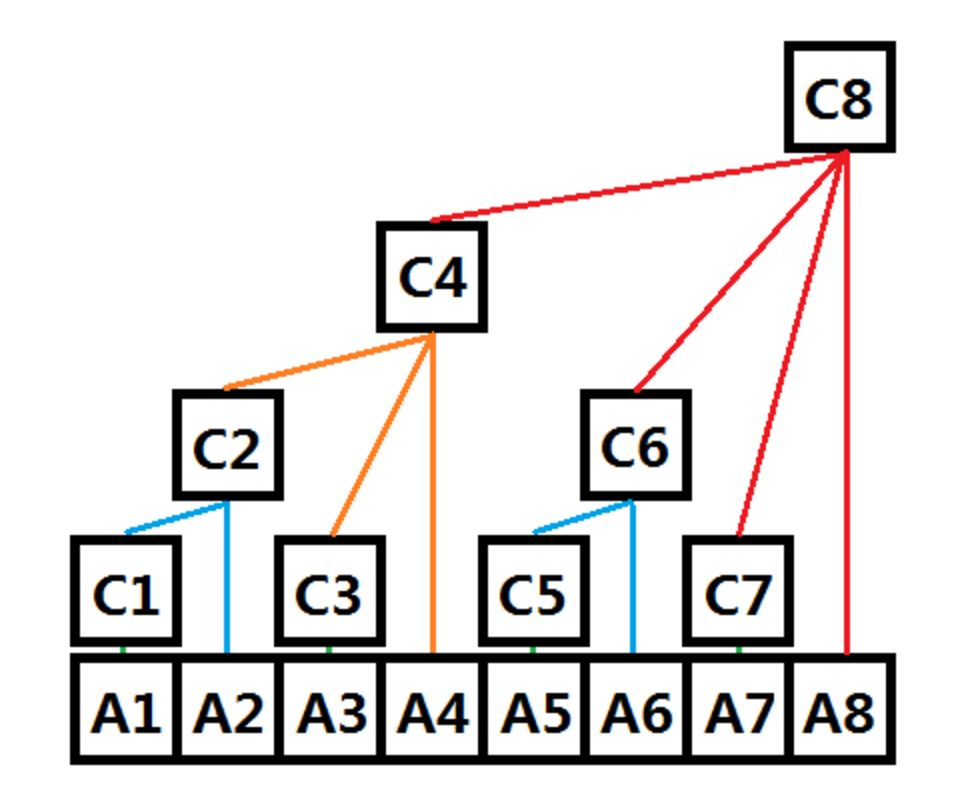树状数组,学长很早之前讲过,最近才重视起来,enmmmm。。。
树状数组(Binary Indexed Tree(B.I.T), Fenwick Tree)是一个查询和修改复杂度都为log(n)的数据结构。主要用于查询任意两位之间的所有元素之和,但是每次只能修改一个元素的值;经过简单修改可以在log(n)的复杂度下进行范围修改,但是这时只能查询其中一个元素的值(如果加入多个辅助数组则可以实现区间修改与区间查询)。
树状数组和线段树很像,但能用树状数组解决的问题,基本上都能用线段树解决,而线段树能解决的树状数组不一定能解决。相比较而言,树状数组效率要高很多。

int lowbit(int x)
{ return x&(-x); }
x&(-x)就是整数x与其相反数(负号取反)的按位与:相同位的两个数字都为1,则为1;若有一个不为1,则为0,即:1&1=1,0&1=0,0&0=0;
计算机中负数使用对应正数的补码来表示。
-x就是x对应的二进制数先各位取反,0变成1,1变成0。然后最低位加1。
举个栗子,4对应二进制为100;-4对应的为011+1=100,所以为(100)&(100)所以为100。
知道这个又能干嘛呀,就可以进行区间查询啦。
区间查询利用C[i]求A数组前i个的和;
//代码1: int SUM(int n)
{ int s=0; while(n>0){ s+=c[n]; n-=lowbit(n); } return s; }
//代码2: int SUM(int n)
{ int s=0; for(int i=n;i>0;i-=lowbit(i)) s+=c[i]; return s; }
两个代码哪个好理解理解哪个。
接着刚刚举的栗子4,求A数组前4个数的和;
lowbit(4)得出100;然后100就是4,所以为s+=c[4];此时i=4,4-lowbit(4)=100-100=0;结束。
再举个栗子7,求前7个数的和,就是s+=A[1]+A[2]+A[3]+A[4]+A[5]+A[6]+A[7];
因为
//代码1: void add(int x)
{ while(x<=N){ ++a[x]; x+=lowbit(x); } }
//代码2: void add(int x,int y)
{ for(int i=x;i<=n;i+=lowbit(i)) c[i]+=y; }
更新过程仔细想一想就是查询过程的逆过程;
举个栗子,更新A1,还要继续更新C[1],C[2],C[4],C[8];
就是C[001],C[010],C[100],C[1000];
i=1;C[1]+=A[1];
lowbit(1)=(001)&(001)=001;此时i=1,所以为1+lowbit(1)=001+001=010,010就是2;C[2]+=A[1];
lowbit(2)=(010)&(110)=010;此时i=2,所以为2+lowbit(2)=010+010=100,100就是4;C[4]+=A[1];
lowbit(4)=(100)&(100)=100;此时i=4,所以为4+lowbit(4)=100+100=1000,1000就是8;C[8]+=A[1];结束。
好了,理解了树状数组就开始贴代码了。(;´д`)ゞ
HDU1541-Stars
Stars
Time Limit: 2000/1000 MS (Java/Others) Memory Limit: 65536/32768 K (Java/Others)
Total Submission(s): 10611 Accepted Submission(s): 4240

For example, look at the map shown on the figure above. Level of the star number 5 is equal to 3 (it's formed by three stars with a numbers 1, 2 and 4). And the levels of the stars numbered by 2 and 4 are 1. At this map there are only one star of the level 0, two stars of the level 1, one star of the level 2, and one star of the level 3.
You are to write a program that will count the amounts of the stars of each level on a given map.
1 #include<iostream> 2 #include<cstdio> 3 #include<cstring> 4 #include<algorithm> 5 #include<bitset> 6 #include<cassert> 7 #include<cctype> 8 #include<cmath> 9 #include<cstdlib> 10 #include<ctime> 11 #include<deque> 12 #include<iomanip> 13 #include<list> 14 #include<map> 15 #include<queue> 16 #include<set> 17 #include<stack> 18 #include<vector> 19 using namespace std; 20 typedef long long ll; 21 22 const double PI=acos(-1.0); 23 const double eps=1e-6; 24 const ll mod=1e9+7; 25 const int inf=0x3f3f3f3f; 26 const int maxn=1e5+10; 27 const int maxm=100+10; 28 #define ios ios::sync_with_stdio(false);cin.tie(0);cout.tie(0); 29 30 31 int a[maxn],ans[maxn]; 32 33 int lowbit(int x) 34 { 35 return x&(-x); 36 } 37 38 int getsum(int n) 39 { 40 int ans=0; 41 for(int i=n;i>0;i-=lowbit(i)) 42 ans+=a[i]; 43 return ans; 44 } 45 46 void add(int x) 47 { 48 for(int i=x;i<=maxn;i+=lowbit(i)) 49 ++a[i]; 50 } 51 52 int main(){ 53 int n,x,y; 54 while(~scanf("%d",&n)){ 55 memset(a,0,sizeof(a)); 56 memset(ans,0,sizeof(ans)); 57 for(int i=0;i<n;i++){ 58 scanf("%d%d",&x,&y); 59 x++; 60 ans[getsum(x)]++; 61 add(x); 62 } 63 for(int i=0;i<n;i++) 64 printf("%d ",ans[i]); 65 } 66 return 0; 67 }
溜了溜了。。。